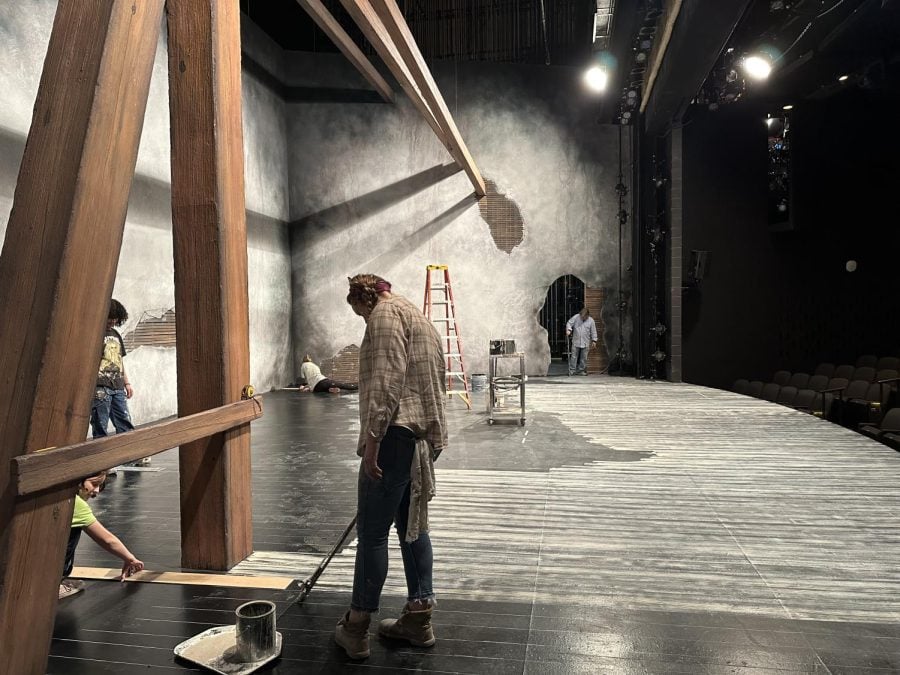Jim Weber brings experience and spontaneity to the scenic arts
Nixie Strazza/Daily Senior Staffer
Scenic artists Jim Weber (right) and Eileen Rozycki (left) both caught the performance arts bug in elementary school before coming to the Wirtz Center.
April 4, 2023
Jim Weber’s love for the arts began in fifth grade with a production of Meredith Willson’s “The Music Man” at his elementary school in Colorado. Between performances, Weber would lend a hand behind the scenes.
Decades after his River City debut, Weber now spearheads the paint shop at the Wirtz Center for the Performing Arts, where he brings to life the atmosphere for dozens of mainstage productions.
Weber said the paint shop, the final stage of the design process, actualizes other creative departments’ vision of texture and aesthetic.
“I use the analogy that the carpentry shop bakes the cake, and we frost it,” Weber said.
After catching the bug for creative expression, Weber decided to major in painting and fine art at Loyola University. His work as a muralist in Chicago led him to pursue work at a professional scene shop, where he learned the ins and outs of the industry for 12 years. In 2008, Weber transferred his skills to the Wirtz Center, and remains an integral part of the theatre scene.
Material choice, color sampling, painting techniques and some improvisation combine to transform paper design plans into full-scale reality, Weber said. With many performances packed into a single season, Weber added that the shop regularly bounces between vastly different projects in the blink of an eye.
“(In) one hour you go from a fairly tidy looking bridge in Paris to a really decrepit looking attic,” Weber said.
To stay on track, the shop takes each artistic process step by step, breaking down an intricate design into foundational pieces. Weber’s team used more than 25 hues specially rendered with the help of a color chart to craft the visual appearance of the floors, backdrop and scenery of the Wirtz Center’s upcoming “Indecent” by Paula Vogel.
Weinberg freshman Jameson Zachery joined the paint shop because she craved creative stimulation. Improving her skill set acquired through high school art and learning wood graining — a painting technique used to make materials to look like wood — are a part of the work-study experience Zachery started Fall Quarter.
Zachery said the hands-on opportunity has been a masterclass in collaboration, giving her newfound confidence in her artistic contributions.
“It’s nice to know that they trust me, and ask my opinion on things and ask me questions,” she said. “I’ve learned to trust myself, and also take into consideration other people’s ideas and practices.”
On top of visual appeal, Weber said the paint shop helps develop a production’s story by creating realistic pieces. If a show requires a hole in the wall or certain type of wood on the floor, the shop’s use of highlights, shadow and shading all factor into a believable final product. Paint makes the scenery appear three-dimensional, Weber said.
Being a scenic artist requires far more teamwork than his solo career as a muralist and painter, Weber said. Executing other designers’ wishes leaves less room for individual flair, he said, but leaves room for artistic touches in heat-of-the-moment decisions.
Like Weber, assistant scenic artist Eileen Rozycki fell in love with theatre through her elementary school set crew. She echoed Weber’s sentiments about a coordinated effort between departments in presenting a final product.
“They give us all the information, but we get to do all the troubleshooting of processes and strategies,” Rozycki said. “We figure out how to recreate what they made and understand how they got there.”
Almost a year into her work at the Wirtz Center, Rozycki’s paint shop highlights include large scale drop painting in the playful style of Matt de la Peña’s storybook for Imagine U’s “Last Stop on Market Street” and hand-painting cork to look like dirt for the 2022 production of “Blood Wedding” by Federico García Lorca.
Aside from overseeing the paintwork for mainstage productions, Weber also teaches a class at Northwestern in scenic art. Described by Weber as a “delightful” opportunity to interact with both undergraduate and graduate students, his course allows for spontaneity — a quality he said other NU departments lack.
Weber said he hopes students left his annual winter session with a willingness to harness flexibility and explore their curiosity.
“A painting may be a thousand decisions, and some of those happen in the spur of the moment,” Weber said. “Thinking on your feet is the fun part.”
Email: [email protected]
Twitter: @NixieStrazza
Related Stories:
— Wirtz Center premieres Renaissance romp and Broadway musical “Something Rotten!”
— ‘Burn with desire’: ‘Blood Wedding’ ignites forgiveness and forbidden love at the Wirtz Center
— “We need a bit more kindness”: Imagine U debuts “Last Stop on Market Street”


